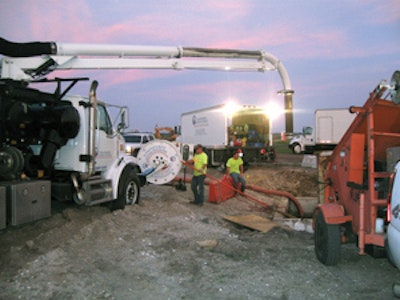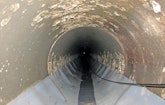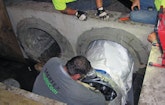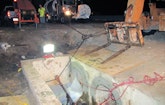
About 85 percent of the joints were leaking in the 30-inch concrete stormwater drains under a runway at the Northeast Florida Regional Airport in St. Augustine. The three 440-foot pipes ran side by side, had joints every three feet and drained tides from the Atlantic Ocean.
Since the runway was due for repaving, Passero Associates, an engineering firm in the city, put out a request for proposals to rehabilitate the drains. Engineered Lining Systems, a Jacksonville-based company with a specialty in cured-in-place pipe and structure restoration, won the bid.
“Passero wanted an environmentally friendly technology because we were close to the Matanzas River estuary,” says production manager James Macko. “We looked for alternatives in conventional cured-in-place products and found SAERTEX-LINER from Saerbeck, Germany.”
Two layers of foil contain the resin within the fiberglass-reinforced plastic liner, and ultraviolet lights cure it. The liners also provide structural support. Third-party test results showed that they have a flexural modulus of 1.7 million psi and flexural strength of 36,000 psi with less than 0.5 percent shrinkage factor.
In addition to the new lining system, the ELS team faced the challenge of working at night. They also had to contend with aircraft traffic, high tides, potential downpours, coordinating crews and other contractors, confined-space entries and oysters.
First things first
Rainstorms in Florida can develop quickly, dropping 0.75 inch of rain at the airport in 30 minutes. Establishing a bypass plan was crucial and required consulting with pump experts. They calculated the massive surface area drained by the storm pipes and recommended the proper bypass pumps to place on standby.
Crews worked from 8 p.m. to 8 a.m. After 9 p.m., airport radio communication switched from the tower to an open frequency. For the workers’ safety, Passero trained superintendent Matt Singletary to talk with the pilots and clear the area for landings and takeoffs. ELS superintendent Danny Knight worked closely with Singletary, holding numerous safety and production meetings before and after work began.
The airport handled up to five flights per night, and workers were not permitted to cross the flight line. They communicated with two-way radios.
“A constant challenge was coordinating where to stage our equipment with contractors laying geotextile fabrics for another project,” says Macko. “We couldn’t be on site while their crews were working.”
Because this was the first time ELS installed a UV-cured liner and the project was one of the largest of its kind in northeast Florida, vice president Mark Hallett and lining technician Maik Kluppels from SAERTEX multiCom arrived from Huntersville, N.C., to assist.
Oyster stew
Oysters covered the circumference of the pipes as far as there was sunlight.
“It’s a common occurrence, but this is the worst case I have ever seen,” says Macko. “They reduced the diameter of the downstream pipe ends by 25 percent for 125 feet. Oysters are about four inches in diameter and extremely tough.”
Workers first plugged the drain inlets and dewatered the pipes with a Gorman-Rupp 6-inch high-flow pump. Tides ranged from 2 feet above the crown to 12 inches below it. Macko constantly monitored the Weather Channel on his laptop, watching the radar for thunderstorms.
Jetter technician Steve Browns used a GapVax MC1510 combination vacuum truck and Lumberjack LJ 700C descaler from NozzTeq to remove the mollusks. Inspection technician Jody Wright followed his progress with a Pipe Ranger system from CUES.
“It’s a real intense process,” says Macko. “Cleaning a drain took one and a half nights because we had to constantly reset the chain flails.”
Browns used short chains to cut an even path on the bottom of the drains for the tool’s skid, then attached longer chains and reset the rollers so the chains hit at the proper angle to the pipe wall. As shell fragments accumulated, he switched to a cleaning head to remove the debris, then returned to the descaler and made another pass at 80 gpm/2,000 psi. A corrugated 2-inch rubber pipe prevented the sharp fragments from cutting the jetter hose.
As a precaution, a worker with confined-space equipment entered the drains after they were mechanically cleaned to remove any remaining oysters that could potentially damage the liner.
Port to port
Macko and Hallett measured the pipes and sketched the runs, then sent the information to the factory in Saerbeck. The custom liners were wetted out, slipped inside UV-protective gray foil sleeves, folded into lightproof crates, and shipped in refrigerated containers to the Port of Jacksonville. Each crate also had a spool of 2-mm-thick gliding foil.
“The factory delivered the liners within five weeks,” says Macko. An ELS refrigerated truck delivered the crates to the site. Nighttime temperatures were 90 degrees F or higher.
As ELS workers plugged, dewatered and jetted a pipe, Kluppels prepared the gliding foil to enter the pipe. He folded the lead edges inward and duct-taped them together to create a narrow profile, then secured a nylon strap to the bundle and attached a pull-in line. He attached a second line at the back of the bundle to pull back the steel-braided winch cable.
As Knight’s crew manually pulled the foil into the drain, two workers at the access pit lubricated the material with a biodegradable dishwashing liquid. The foil would protect the liner and facilitate its passage.
Meanwhile, workers positioned the leading edges of the 12,000-pound liner inward and secured them with three ratchet straps, forming a nose. An elaborate winch system involving blocks, the forklift and an adapted bucket machine pulled the liner into the pipe.
Fast and clean
“This is where things got interesting,” says Macko. “The operator had to coordinate the speed of the winch with the crew unfolding and passing the liner into the pipe. We pulled 30 to 40 feet per minute, double-checking everything as the liner went in.”
Once the liner was inserted, Kluppels slipped a steel packer in the rear of the liner and secured it with a ratchet strap. He installed another packer in the nose, then pressurized the liner at 6 psi to insert the UV light train with temperature sensors and a fixed camera on both ends.
A power cable attached to the light train enabled Kluppels to pull it through the liner as Knight inspected it for imperfections and fit on the CCTV monitor.
“This product has great quality control,” says Macko. “The resin has a photo initiator and cures only under ultraviolet light. If anything goes wrong, we can turn off the lights, release the air pressure, adjust the liner, inflate it again, turn on the lights, and continue as if nothing had happened.”
After Kluppels set certain fields in the operating program, he ignited the eight 1,000 W UV lights and the computer controlled the speed of the cable reel, which pulled the lights upstream at 1.65 feet per minute. As temperatures reached a maximum and a minimum, the computer adjusted the speed.
“It would have taken 20 to 30 hours of running big boiler trucks to heat enough water to steam cure this much liner,” says Macko. “The UV system allowed us to install one liner per night and immediately recommission the drain line. The benefits of GRP liners are outstanding. We believe they are the next generation of trenchless technology.”









